KERASHAFT: Bioactive peptides for hair restructuring and hair plex
Kerashaft: Hair care
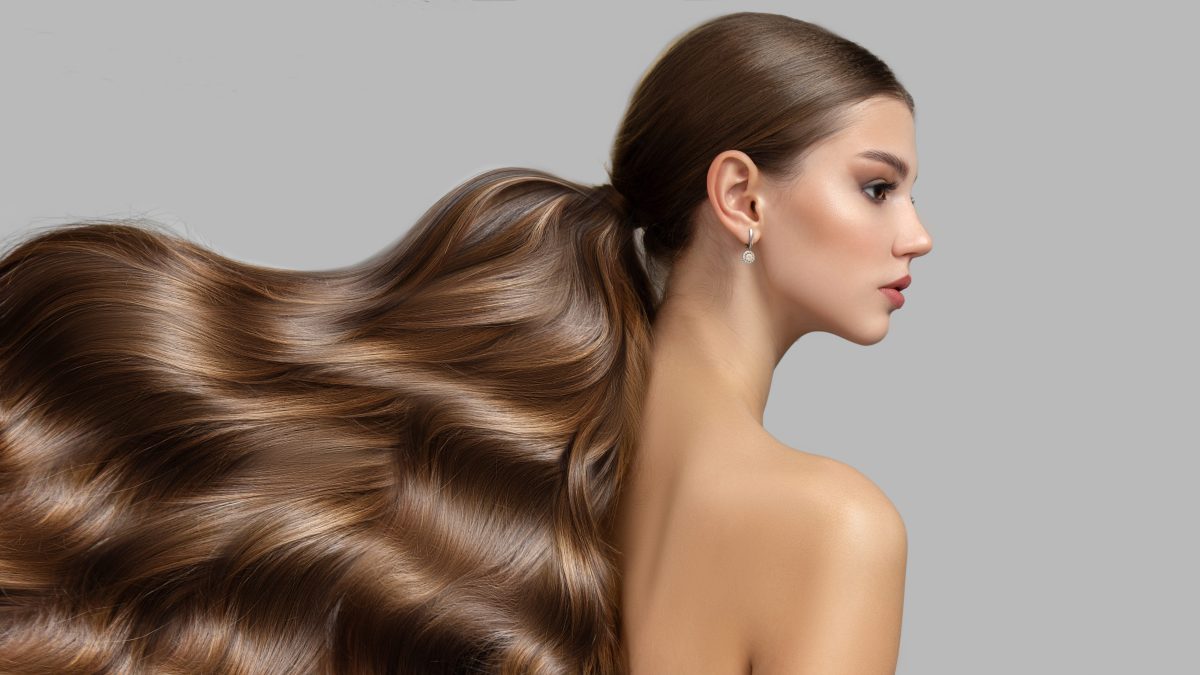
21 February 2023
Faced with the continuous evolution of the global cosmetic market, the hair care industry continues its growth supported by a marked extension and diversification of claims and consumer needs, as well as by the growth of expanding economic realities.
Recent market research identifies emerging economies such as India, Indonesia, Brazil, South Africa, Colombia and China with extremely high CAGR (compound annual growth rate) values linked to the development of hair care products.
More mature markets such as USA, Japan, UK and France are instead set for growth in the per capita economic value of hair care products. The raising of the quality of hair care products plays a decisive role in such context, mainly in connection to the diversification of marketing claims, closely linked both to ethical issues and to the increasing consumer needs.
In this new ecosystem, the need to choose products compliant to consumer demands linked to philosophies such as clean and clinical beauty, or the search for environmentally sustainable specialities or relevant to social inclusion matters – such as gender, and heterogeneity of hair textures – have emerged.
The common denominator of these new elements remains the search of versatile specialities with proven activity and specificity. Not surprisingly, today we hear about ‘skinification’ of the hair care industry (intended as the need to target more effectively the hair products with the same depth of evaluation that applies in skin care), to demonstrate the radical change in the selection requirements of the NPD.
Kerashaft technology rationale
In line with the hair care skinification trend, Kalichem has developed Kerashaft technology, a family of actives aimed to regenerate the hair and privilege applicative and post-applicative sensory pleasantness. The actives discussed here are Kerashaft V (INCI: Hydrolyzed Vegetable Protein) and Kerashaft Q (INCI: Hydroxypropyltrimonium Hydrolyzed Vegetable Protein), both developed through a meticulous selection of vegetable bio-active peptides in full compliance with the restrictive parameters of eco-sustainability required by the market.
The development rationale for these products focused on restoring hair fibre integrity based on the knowledge of its structural composition, tridimensional order and interactions established by its components with external factors.
The structure of hair
Hair structure is composed of cuticle, cortex, and medulla. The cuticle is the outermost protective layer that provides sensory and shine characteristics. The cuticles overlap like roof shingles, protecting the hair from chemical and physical treatments. The cortex is the major component of hair and is responsible for its mechanical strength and pigmentation. The innermost layer is the medulla.
The structural integrity of hair is due to its specific chemical composition, primarily keratin proteins, lipids, and water. These proteins are complex natural compounds that contribute to hair’s physicochemical properties. Human hair keratin is unique due to its higher cysteine residue content than skin keratin, which is 7.6% and 2.9% respectively. Higher levels of cysteine residues in hair lead to higher amount of inter- and intramolecular disulfide bonds, which translates to a durable structure due to covalent bonds.
The remarkable mechanical resilience of hair fibre is due to its complex protein structure enforced by multiple types of bonds: covalent bonds, ionic bonds, hydrophobic forces, and hydrogen bonds. Tensile strength, as manifestation of the hair overall mechanical properties, has been studied extensively and is best described by the strain/stress curve of a single hair fibre.
The fibre elongation due to continuous extension force exhibits distinct regions of elastic and thixotropic behaviour, which are significantly influenced by the humidity conditions. While the precise impact of all bond types on hair’s tensile strength is not yet fully understood, the role of disulfide bonds has been researched extensively.
Disulfide bridges (bonds) across the amorphous proteins in the cortex create a matrix within which the crystalline microfibrils are embedded and stabilized. Due to the permanent conversion of cystine to cysteic acid during bleaching, the matrix cross-linking degree is expected to be reduced.
Hair is also comprised of 1-9% lipids, which contribute to enhanced conditioning properties such as flexibility, surface gloss, and lubricity of hair. Lipids in the internal part of hair provide structural reinforcement and rigidity water is another component that can comprise up to 32% w/w of hair. It supports the formation of a network of hydrogen bonds with proteins, thereby influencing the tensile strength, swelling, flexibility, and shape of hair and the formation of salt bridges.
Kerashaft development rationale is based on providing the hair shaft with bio-available sulphurated and low polar aminoacids able to re-establish the homeostatic conditions of the hair fibres, especially after exposure to aggressive daily cosmetics treatments (frequent use of aggressive formulations), stressful environmental conditions (excessive UV exposure) and salon treatments (bleaching, dyes, perms, straightening etc.), repairing structural damages leading to dry and straw- like properties that make hair frizzy, difficult to style, comb and easily broken.
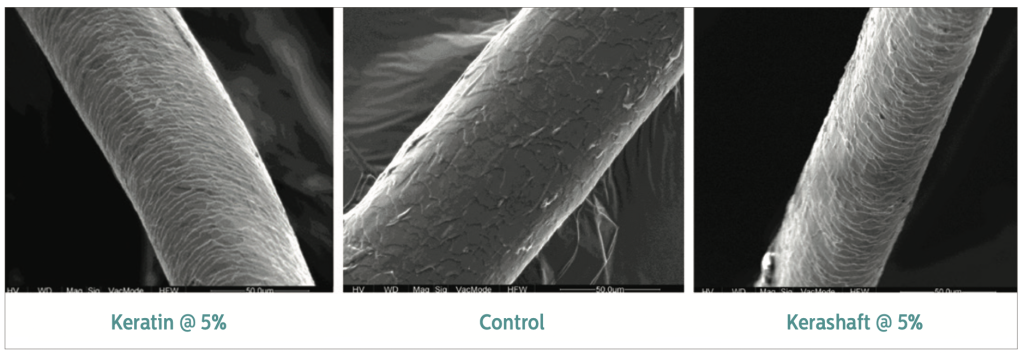
Test protocols: Hair conditioning
Caucasian hair strands were bleached, to damage both the cuticle and cortex. Subsequently each strand was washed with shampoo, treated with 0.5 ml of sample and dried: the tresses were analyzed with four samples (hydrolyzed keratin solution, Kerashaft V solution, Kerashaft Q solution and control) and dried after five minutes.
Additional assessment was made on Caucasian hair, comparing longitudinal and transversal sections of virgin hair subject to bleaching. Homogeneous locks were collected, standardized in number, weight, and length. The analysis was carried out in a closed room, at controlled temperature and humidity at the same time of day. All the strands were subject to washing with a 3% (v/v) solution in SLES- purified water, to remove dirt and cosmetic products.
Afterwards, the washed and dry hair, after a stationing time of 24 hours, was divided into two groups for each type, treated and untreated. Treated hair was then put in contact for five minutes with a serum, subsequently subject to drying with hairdryer for five minutes; the untreated hair is directly subject to analysis. The images of virgin hair, dyed and bleached, treated and not, were compared through scanning electron microscopy (SEM).
Restructuring, hydration and luminosity actions
A lock was subject to washing with common shampoo, dried with hairdryer and subsequent plate at 220 °C in order to obtain the reference standard. The same treatment was made on locks treated with three samples: 0.5 ml Kerashaft V, hydrolyzed keratin and Kerashaft Q solutions, each of them used at 5%.
Additional studies aimed to evaluate the comparison against a market benchmark based on vegetable derived protein hydrolysate were carried out. In this case, the treatment was made using both the active object of the study and the benchmark at a 1.5% dosage; before this treatment, 12 tresses were subject to level- ten bleaching and chemical physical damage through ammonium thioglycolate and hydrogen peroxide, followed by oven heating.
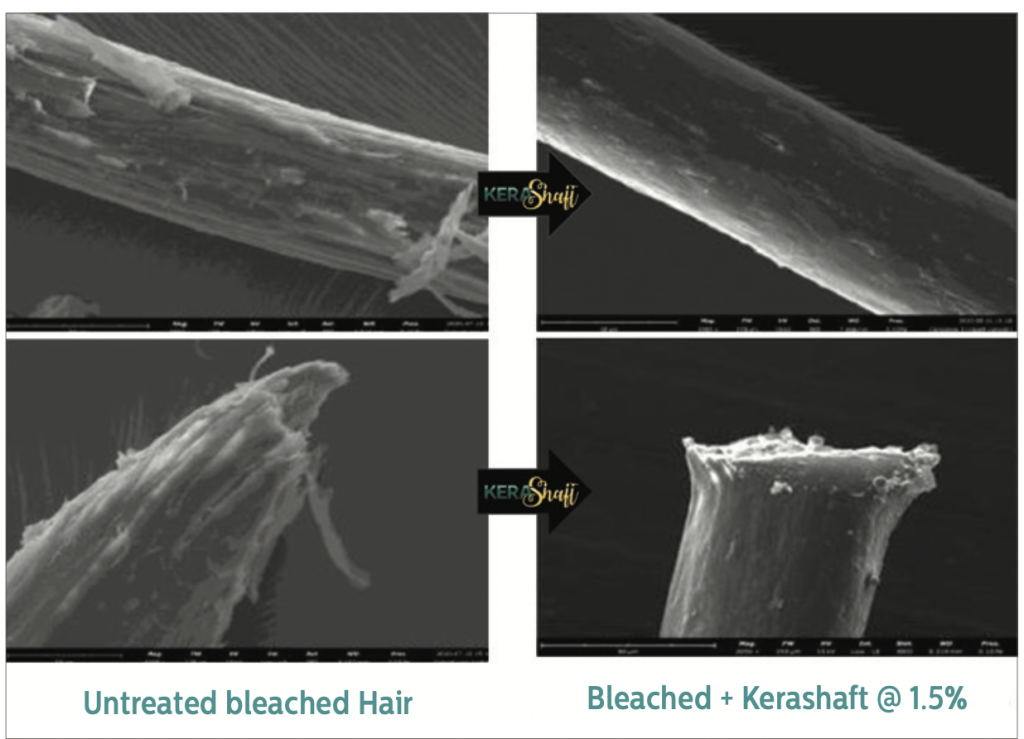
The treated hair was placed on a pretreated slide and subject to polarized microscope analysis. The hair pictures before and after treatment were compared. Instrumental measurements in image quality were conducted with polarized light microscope and image recording.
Keratin is a crystalline protein able to delay the wave of polarized light; the hair shaft appears under the microscope as luminous and colourful on a black background. There are wave delays, visible as colours, “colours of polarization “, and due to the thickness of the keratin for which each colour, based to Newton’s scale, a precise diameter corresponds.
Wave delays due to the crystallographic orientation, and wave delays due to the pigment contained in the keratin, are referred to as ‘clearing colours’: visible colour implies a specific structural order and tidiness. This technique applied to trichology enables to observe the crystallographic hair structure.
For hair restructuring and analysis of its elemental composition, EDX microanalysis was carried out to provide the elementary analysis of the shaft samples before and after the treatments.
Thermogravimetric analysis allows to determine the moisture content present in liquid, porous and solid substances. The thermobalances weigh and dry the sample through IR heater which weighs and dries at the same time the humidity, enabling to calculate the percentage value of the dry residue or aqueous content. Through constant measurements of weight variations during drying, the thermobalance allows to extract all the humidity present in a sample and calculate: initial weight, dry residual weight, and the initial percentage of moisture present.
Further assessments were performed through the quantification and comparison of the volume of virgin and treated hair with a base shampoo concentrated with 1.5% Kerashaft V. Homogeneous tresses were collected and prepared and standardizing by weight and length; the analysis was carried out in a closed room, at controlled temperature and humidity at the same time of day, after a standing time of about 24 hours.
Hair tresses were treated with a 3% (v/v) solution in purified water of the shampoo, left in contact with it for two minutes, then rinsed for one minute and dried with a hairdryer for five minutes. Before the application of the product, and after the washing-test, readings were done through PLM (polarized light microscopy) microscope, enabling to obtain macroscopic dimensional determination. The measurements were recorded using a high-resolution camera and compared to each other.
For colorimetric analysis, the colour measurement was done using a Colorimeter CL 400 made by Courage & Khazaka. The probe emits white LED light. The light reflected is measured in the probe and expressed appropriately. The measured hair colour is expressed as XYZ tristimulus values and can be calculated in the L * a * b * system.
Resistance to traction and combing test
These parameters were analyzed through a treatment on twelve strands of Caucasian bleached hair. Six strands were treated with a standard conditioning benchmark treatment (shampoo + conditioner based on vegetable amino-acids complex claimed as “phyto- keratin”).
Another six locks were treated with a shampoo and conditioner (containing Kerashaft @ 1.5%). The tensile test was run through the digital dynamometer ZTS 550N made by Imada. The bundle was strained and after the breakage, the maximum force, average force, and time to reach the max peak were obtained.
For the combing test, combing was analyzed through ZTS 550N that measures the friction generated between a comb/brush and hair during grooming. Therefore, lubrication is evaluated by decreasing grooming forces for product-treated hair relative to the standard control. After grooming, the following parameters were obtained (maximum force and average force).
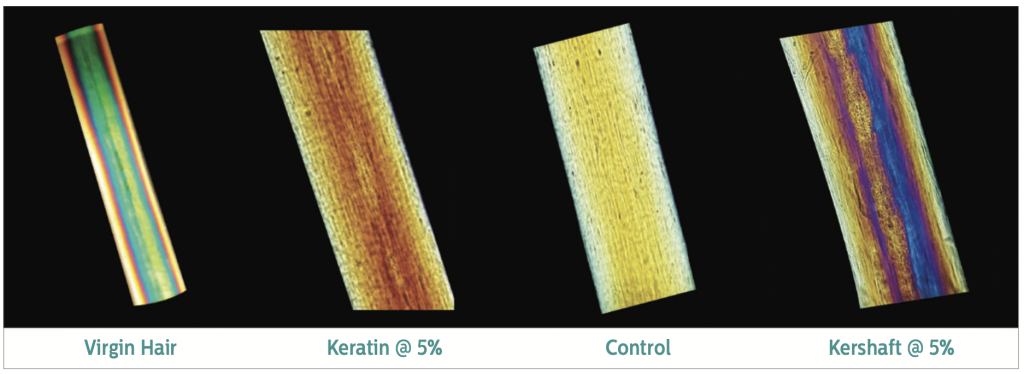
Results: Kerashaft V - hair surface conditioning
SEM analysis prove that the bleached hair treated with control sample shows uneven weft with fiberisation and non-overlapped crusting, while the leave-on treatments with Kerashaft V and hydrolyzed keratin @5% (Figure 1), induce remarkable improvement in longitudinal section of the cuticle crusting overlapping and effective and homogeneous filling in the transversal section (data not shown, available on demand).
The longitudinal and transversal sections were also analyzed with a lower dosage treatment of Kerashaft V @ 1.5%. The treatment shows a visible strengthening of the cuticular scales, given by the active ingredient’s capability of settling on the surface of the hair and filling of the cracks and holes caused by the invasive chemical treatments (clearly visible in the untreated bleached hair). The formation of the white flakes at the joints detected on the untreated hair is totally avoided by the treatment, as proven by the sealing of the end portions after the application.
Hair restructuring and plex effect PLM tests show that compared to hydrolyzed keratin, Kerashaft V @ 5% used in leave-on application shows more effective restructuring action at cortex and peri-medular area than a benchmark hydrolyzed keratin treatment, as its crystallography follows the same pattern of virgin hair.
Similar behaviour and performances were observed with a treatment @1.5% against a benchmark phyto-keratin. Kerashaft V treated hair shows more defined and diversified polarization colours, particularly after the drying treatment. This specific activity pattern is likely ascribable to the restructuring features linked to:
Increased delivery of bio-available sulphur content detected after EDX microanalysis; in detail, the Kerashaft treatment showed an average of +325% sulphur found on the shaft. Hydrolyzed keratin treated hair showed overall amounts of 5.6% in weight of sulphur, while Kerashaft treatment increased hair sulphur content up to 21.4%.
Increased hair shaft hydrophobic character, using as indicator the overall carbon atom content. The treatment showed a carbon content increase by 16% versus keratin.
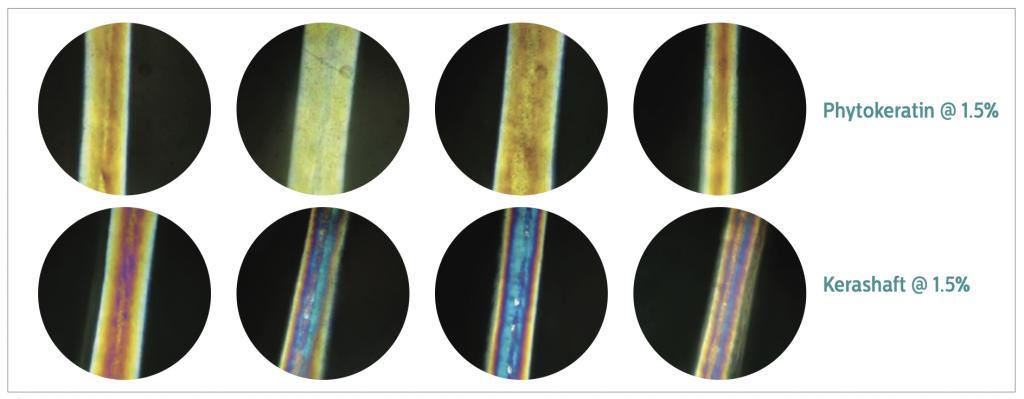
Resistance to traction and combing
The leave-on treatment with Kerashaft V @1.5% showed consistent improvements of the firmness of the hair compared to a phyto-keratin treatment, according to the following data:
- Increased resistance to breakage: the treated hair resists tensile stress for a more extended period than benchmark treated strands (ten seconds more, + 37%).
- Increased resistance to traction: the treated hair reported +64% breakage force load.
- Improvement of hair combability. Treated hair opposes less resistance to the passage of the comb (-37%) than phyto-keratin treatment.
Moisturising and volumising action
Kerashaft V @ 5% treated hair loses more mass than the benchmark keratin treated hair after exposure to infrared heat when compared to the mass recorded immediately. The values shown in Figure 5 suggest its higher imbibition power, swelling and hydration potential. Complementary analysis calculating relative humidity loss through thermobalance (data not shown, available on demand) confirm the activity pattern.
Additional studies made after a rinse-off treatment based on a shampoo containing Kerashaft V @ 1.5% compared to virgin hair proved volumising increase by 17% for single hair units average diameter, and +10% for hair tresses average diameter.
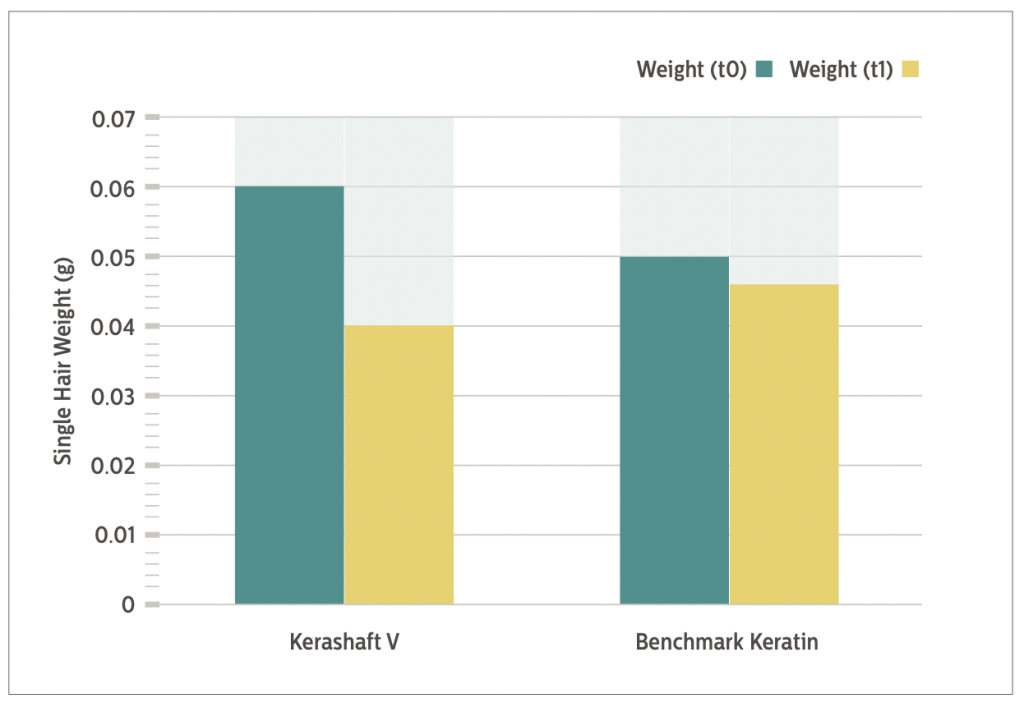
Kerashaft Q & Conclusion
Hair detangling and restructuring features following a leave-on treatment @ 5% were assessed, respectively, through SEM and PLM analysis. SEM images show the full closure of cuticles all over the shaft longitudinal surface.
PLM images show its refined plex and restructuring effect, linked to an average increased delivery of sulphur by 49.2% when compared to hydrolyzed keratin treatments (with a load of sulphur detected of 8.1%, compared to the 5.6% recorded by keratin).
The active also improved hair luminosity after a leave-on treatment followed by straightening. The luminous effect recorded is represented by a Δ of the colorimeter L* value of + 4.3 compared to the lower value of 0.4 induced by the treatment with hydrolyzed keratin.
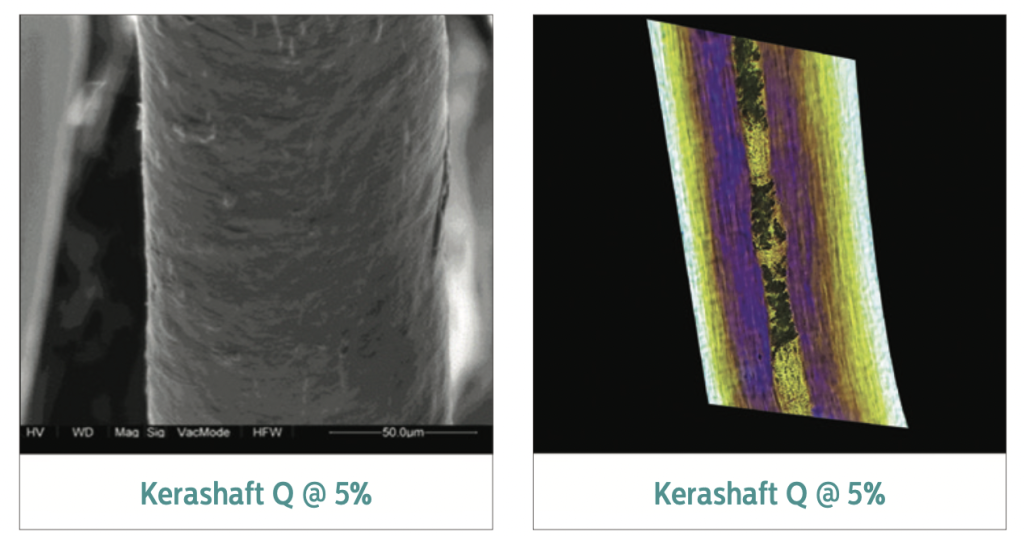
Conclusion
In light of the scientific objectification described, Kerashaft bioactive peptides represent an ideal solution to promote plex, restructuring, hydration, combing improvement, volumising (Kerashaft V), detangling, antistatic, conditioning, and luminosity effects (Kerashaft Q).
These specific features reflect the capability of both the actives analyzed to deeply nourish and repair the damaged hair shaft thanks to their increased delivery of sulphur (enabling to re-establish disulfide bonds all over the hair inner structure) and the modulation of the global polarity of the hair amino-acidic content, bringing it to homeostatic values.
The hydro-soluble nature of these products makes them suitable for multiple applications (including shampoo, conditioners, masks, gels, serums, lotions, thermal hair protectors etc.)
for daily home treatments, salon professional treatments (split end repair, plex, anti-frizz, Brazilian keratin, lamination and hair gloss treatments) and healing cosmeceutical products (post-bleaching, post-dye, post-perm, etc).
Ingredients
Formulations
Restructuring Shampoo
Cosmos compliant shampoo, sulfate free, good viscosity, creamy foam, transparent, vegetable gums free. Specific for curly hair.
Hair Softening Shampoo
Sulfate free shampoo, formulated with a cocktail of natural derived surfactants based on olive oil and a unique hair strenghtener (STIMUCAP). Good viscosity, creamy foam, transparent formulation.
Detangling Shampoo
Sulfate free shampoo, formulated with natural derived detangling active (KERASHAFT Q). Good viscosity, creamy foam, transparent, vegetable gums free.
Shower Shampoo
Shower shampoo based on patented olive based surfactant with filming and protective activity on the hair. Cream foam, transparent formula.












